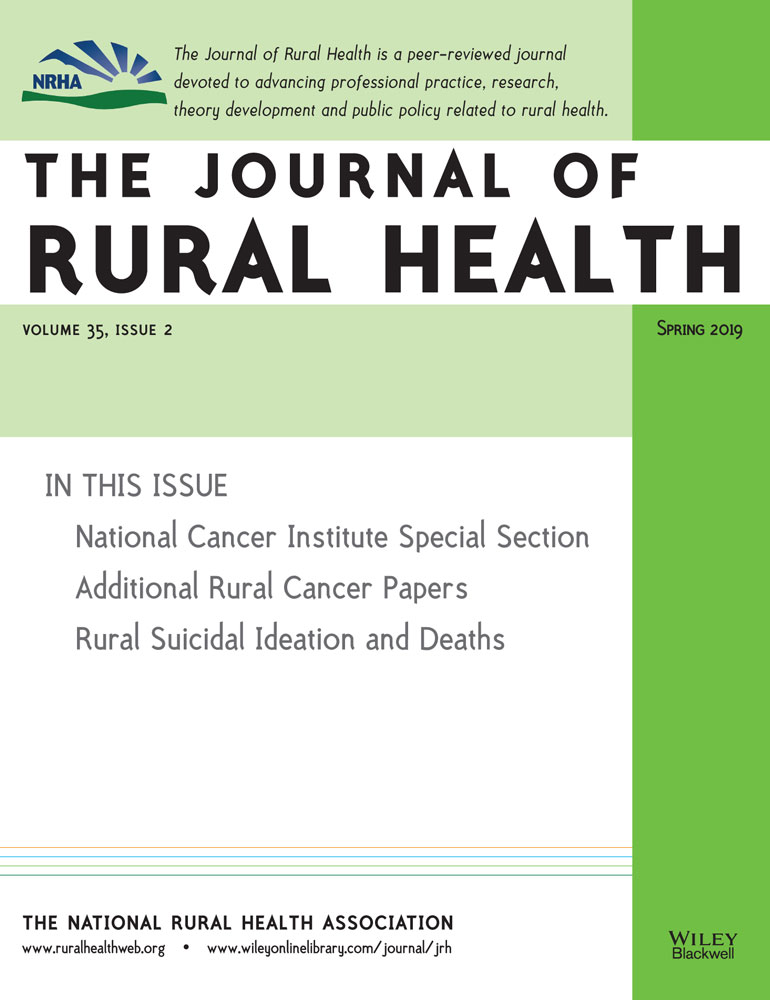COMMENTARY
Rurality, Rural Identity, and Cancer Control: Evidence from NCI's Population Health Assessment in Cancer Center Catchment Areas Initiative
Kelly D. Blake ScD,
Robert T. Croyle PhD,
Corresponding Author
Kelly D. Blake ScD
Division of Cancer Control and Population Sciences, National Cancer Institute, National Institutes of Health, Bethesda, Maryland
For further information, contact: Kelly D. Blake, 9609 Medical Center Drive, Rm 3E222, MSC 9671, Bethesda, MD 20892–9671; e-mail: [email protected].Search for more papers by this authorRobert T. Croyle PhD
Division of Cancer Control and Population Sciences, National Cancer Institute, National Institutes of Health, Bethesda, Maryland
Search for more papers by this authorKelly D. Blake ScD,
Robert T. Croyle PhD,
Corresponding Author
Kelly D. Blake ScD
Division of Cancer Control and Population Sciences, National Cancer Institute, National Institutes of Health, Bethesda, Maryland
For further information, contact: Kelly D. Blake, 9609 Medical Center Drive, Rm 3E222, MSC 9671, Bethesda, MD 20892–9671; e-mail: [email protected].Search for more papers by this authorRobert T. Croyle PhD
Division of Cancer Control and Population Sciences, National Cancer Institute, National Institutes of Health, Bethesda, Maryland
Search for more papers by this authorDisclosure: The authors declare no conflicts of interest.
No abstract is available for this article.
References
- 1Paskett ED, Hiatt RA. Catchment areas and community outreach and engagement: The new mandate for NCI-designated cancer centers. Cancer Epidemiol Biomarkers Prev. 2018; 27: 517-519.
- 2 National Institutes of Health. National Cancer Institute: Cancer Center Support Grants (CCSGs) for NCI-designated Cancer Centers (P30) (PAR-12-298). Bethesda, MD: National Cancer Institute; 2012.
- 3 National Institutes of Health. National Cancer Institute: Cancer Center Support Grants (CCSGs) for NCI-designated Cancer Centers (P30) (PAR-17-095). Bethesda, MD: National Cancer Institute; 2016.
- 4Zahnd WE, James AS, Jenkins WD, et al. Rural-urban differences in cancer incidence and trends in the United States. Cancer Epidemiol Biomarkers Prev. 2017; 27(11): 1265-1274.
- 5Henley SJ, Anderson RN, Thomas CC, et al. Invasive cancer incidence, 2004–2013, and deaths, 2006–2015, in nonmetropolitan and metropolitan counties—United States. MMWR. Surveillance summaries. 2017; 66: 1-13.
- 6Blake KD, Moss JL, Gaysynsky A, et al. Making the case for investment in rural cancer control: an analysis of rural cancer incidence, mortality, and funding trends. Cancer Epidemiol Biomarkers Prev. 2017; 26: 992-997.
- 7Onega T, Alford-Teaster J, Wang F. Population-based geographic access to parent and satellite National Cancer Institute Cancer Center Facilities. Cancer. 2017; 123: 3305-3311.
- 8 National Cancer Institute. Improving cancer control in rural communities: next steps, Cancer Currents Blog. Bethesda, MD: National Cancer Institute; 2017.
- 9 National Cancer Institute. Improving cancer control in rural communities: an interview with Dr. Robert Croyle, Cancer Currents Blog. Bethesda, MD: National Cancer Institute; 2016.
- 10Befort CA, Nazir N, Engelman K, et al. Fatalistic cancer beliefs and information sources among rural and urban adults in the USA. J Cancer Educ. 2013; 28: 521-526.
- 11Crosby RA, Collins T. Correlates of community-based colorectal cancer screening in a rural population: the role of fatalism. J Rural Health. 2017; 33(4): 402-405.
- 12Howat A, Veitch C, Cairns W. A descriptive study comparing health attitudes of urban and rural oncology patients. Rural Remote Health. 2006; 6(4): 563.
- 13Katz ML, Reiter PL, Heaner S, et al. Acceptance of the HPV vaccine among women, parents, community leaders, and healthcare providers in Ohio Appalachia. Vaccine. 2009; 27: 3945-3952.
- 14Katz ML, Wewers ME, Single N, et al. Key informants' perspectives prior to beginning a cervical cancer study in Ohio Appalachia. Qual Health Res. 2007; 17: 131-141.
- 15Krok-Schoen JL, Palmer-Wackerly AL, Dailey PM, et al. The conceptualization of self-identity among residents of Appalachia Ohio. J Appalachian Stud. 2015; 21: 229-246.
10.5406/jappastud.21.2.0229 Google Scholar
- 16Reiter PL, Katz ML, Ferketich AK, et al. Appalachian self-identity among women in Ohio Appalachia. J Rural Commun Psychol. 2009; 12: 1-13.
- 17Royse D, Dignan M. Fatalism and cancer screening in Appalachian Kentucky. Fam Community Health. 2011; 34: 126-133.
- 18Spleen AM, Lengerich EJ, Camacho FT, et al. Health care avoidance among rural populations: results from a nationally representative survey. J Rural Health. 2014; 30(1): 79-88.
- 19Vanderpool RC, Dressler EVM, Stradtman LR, et al. Fatalistic beliefs and completion of the HPV vaccination series among a sample of young Appalachian Kentucky women. J Rural Health. 2015; 31(2): 199-205.




